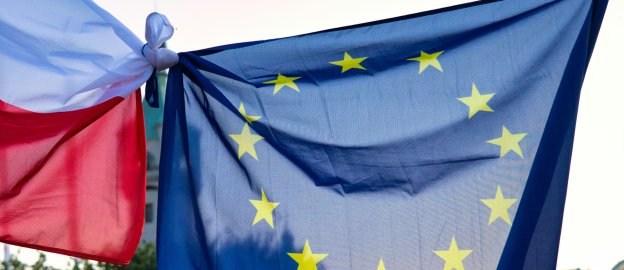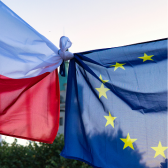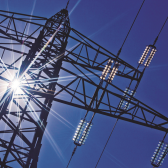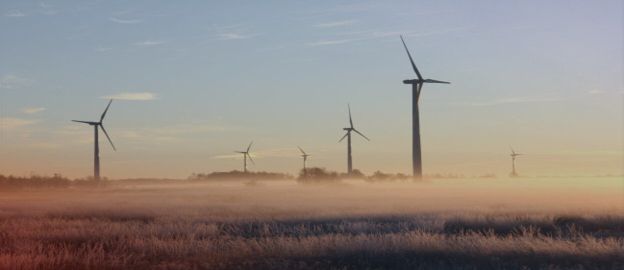European Commission priorities for 2024-2029. The view from Poland on energy and climate

The upcoming European Parliament elections will open a new chapter in EU climate and energy policy. The new European Commission, which begins its 5-year term in the fall, will have to monitor the implementation of a wide range of files related to the ‘Fit for 55’ package and navigating the Union towards the 2050 goals by setting targets for 2040. It will also certainly propose a new political strategy, as the dynamics of the discussion in the EU is in a state of constant flux. From Poland’s perspective, what new priorities of the European Commission will be most important and gain support and interest?
Read More
European Commission priorities for 2024-2029. The view from Poland on energy and climate
The upcoming European Parliament elections will open a new chapter in EU climate and energy policy. The new European Commission, which begins its 5-year term in the fall, will have to monitor the implementation of a wide range of files related to the ‘Fit for 55’ package and navigating the Union towards the 2050 goals by setting targets for 2040. It will also certainly propose a new political strategy, as the dynamics of the discussion in the EU is in a state of constant flux. From Poland’s perspective, what new priorities of the European Commission will be most important and gain support and interest?

Eighth capacity market auction—high time for the flexibility market

At the end of December, one of the last power market auctions took place. Under this form of state aid, contracts so far concluded have been for nearly PLN 90 billion (nominally), which will be repaid until 2044. Financing for them comes from electricity consumers, in the average household electricity bill, in which the power market fee accounts for about 7%. This mechanism, although costly, allows maintaining capacity in the power system. So far, however, it has mainly generated subsidies for existing and new coal and gas-fired power plants. The eighth auction turned out to be different from the previous ones: it was decentralised, clean, cheaper and battery-based. Instead, there is no new generating capacity.
Read More
Eighth capacity market auction—high time for the flexibility market
At the end of December, one of the last power market auctions took place. Under this form of state aid, contracts so far concluded have been for nearly PLN 90 billion (nominally), which will be repaid until 2044. Financing for them comes from electricity consumers, in the average household electricity bill, in which the power market fee accounts for about 7%. This mechanism, although costly, allows maintaining capacity in the power system. So far, however, it has mainly generated subsidies for existing and new coal and gas-fired power plants. The eighth auction turned out to be different from the previous ones: it was decentralised, clean, cheaper and battery-based. Instead, there is no new generating capacity.

Planning Poland’s Climate and Energy strategies in a new political opening

Poland’s new coalition government has declared a new opening in energy policy and offers much more ambitious transition goals, although the details of which are yet to be worked out. One of the first tasks of the new government is to propose a series of climate and energy strategies. Polarised opinions, attempts at disinformation, and political tension will make creating these guiding documents quite difficult. The preparation of the country's new energy and climate policy should be underpinned by sound analyses to justify the choices made. A council composed of the country's leading experts should be established to be a substantive voice in the process.
Read More
Planning Poland’s Climate and Energy strategies in a new political opening
Poland’s new coalition government has declared a new opening in energy policy and offers much more ambitious transition goals, although the details of which are yet to be worked out. One of the first tasks of the new government is to propose a series of climate and energy strategies. Polarised opinions, attempts at disinformation, and political tension will make creating these guiding documents quite difficult. The preparation of the country's new energy and climate policy should be underpinned by sound analyses to justify the choices made. A council composed of the country's leading experts should be established to be a substantive voice in the process.

How to ‘uncoal’ Poland

The new government has a long list of decisions to make. Neglected power plant repairs, the poor condition of distribution networks, an unfinished project to spin off coal assets, and a declining mining industry. On top of that, there is downward pressure on electricity prices. Each of these areas requires immediate decisions and large amounts of money.
Read More
How to ‘uncoal’ Poland
The new government has a long list of decisions to make. Neglected power plant repairs, the poor condition of distribution networks, an unfinished project to spin off coal assets, and a declining mining industry. On top of that, there is downward pressure on electricity prices. Each of these areas requires immediate decisions and large amounts of money.

How to escape the household energy price trap?

Household electricity prices in recent months bore little relation to real production costs, were kept artificially low and treated as an interface with voters. State intervention in this area was necessary in 2022 due to unprecedented price increases on the markets. If the price-freezing mechanisms expire as planned at the end of 2023, electricity prices for households could rise by up to 68% in January. The impact of price spikes should be mitigated. We are proposing a package of solutions: an energy voucher, support for distribution tariffs, additional money for improving the energy efficiency of buildings and a special tariff for heating buildings with electricity.
Read More
How to escape the household energy price trap?
Household electricity prices in recent months bore little relation to real production costs, were kept artificially low and treated as an interface with voters. State intervention in this area was necessary in 2022 due to unprecedented price increases on the markets. If the price-freezing mechanisms expire as planned at the end of 2023, electricity prices for households could rise by up to 68% in January. The impact of price spikes should be mitigated. We are proposing a package of solutions: an energy voucher, support for distribution tariffs, additional money for improving the energy efficiency of buildings and a special tariff for heating buildings with electricity.

Electricity market design: one size won’t fit all

The energy crisis has highlighted imperfections in the EU power market. The current rules were created almost 30 years ago with the aim to incentivise large conventional power plants, but they now need to be adapted to new challenges.
Read More
Electricity market design: one size won’t fit all
The energy crisis has highlighted imperfections in the EU power market. The current rules were created almost 30 years ago with the aim to incentivise large conventional power plants, but they now need to be adapted to new challenges.

Conclusions from the 7th capacity market auction - cleaner, but adequacy remains a challenge

The results of the seventh auction in the Polish capacity market clearly show the dilemma Poland has faced - existing high-carbon (coal) capacity can no longer be supported with this mechanism, while gas is risky due to the geopolitical situation. Although Polish energy companies have not completely abandoned gas projects, fewer appeared in the auction than previously announced. There is also clearly a greater variety of technologies than before - for the first time, contracts were granted to storage. The market is still expensive - for the second year in a row auctions ended in the first round and at the maximum price.
Read More
Conclusions from the 7th capacity market auction - cleaner, but adequacy remains a challenge
The results of the seventh auction in the Polish capacity market clearly show the dilemma Poland has faced - existing high-carbon (coal) capacity can no longer be supported with this mechanism, while gas is risky due to the geopolitical situation. Although Polish energy companies have not completely abandoned gas projects, fewer appeared in the auction than previously announced. There is also clearly a greater variety of technologies than before - for the first time, contracts were granted to storage. The market is still expensive - for the second year in a row auctions ended in the first round and at the maximum price.

Renewables can reduce fuel imports

Last year the import of gas, oil and coal cost Poland PLN 89 billion. This year, it will be much more - by the end of June it already amounted to PLN 85 billion. The supply crunch and spike in fuel prices have become the source of an economic and energy crisis, and a means of exerting pressure on Europe. Meanwhile, renewables not only reduce emissions and energy prices, but also import dependency on energy resources.
Read More
Renewables can reduce fuel imports
Last year the import of gas, oil and coal cost Poland PLN 89 billion. This year, it will be much more - by the end of June it already amounted to PLN 85 billion. The supply crunch and spike in fuel prices have become the source of an economic and energy crisis, and a means of exerting pressure on Europe. Meanwhile, renewables not only reduce emissions and energy prices, but also import dependency on energy resources.

How to maintain Belchatow's energy future

Europe is going through its biggest energy crisis ever. The attention of decision makers is focused on ensuring energy and heat supplies in the coming months. Meanwhile, long-term challenges and problems in the energy sector that have not been solved before are only accumulating. One of them is the future of the largest power plant in Poland.
Read More
How to maintain Belchatow's energy future
Europe is going through its biggest energy crisis ever. The attention of decision makers is focused on ensuring energy and heat supplies in the coming months. Meanwhile, long-term challenges and problems in the energy sector that have not been solved before are only accumulating. One of them is the future of the largest power plant in Poland.

Ukraine’s Preparations for a Wartime Winter

Ukraine has prepared relatively well for the heating season, despite the Russian invasion and subsequent war, which has been ongoing for more than six months. The accumulated stocks of coal and gas are likely to be sufficient to ensure heat and electricity supply. The decline in demand for electric power due to reduced economic activity during the war is greater than the lost generation potential, enabling Ukraine to export electricity to the EU. The biggest challenge will be to secure heating if the Russian shelling of CHP plants intensifies. This could cause a humanitarian catastrophe in Ukraine and increase the number of refugees.
Read More
Ukraine’s Preparations for a Wartime Winter
Ukraine has prepared relatively well for the heating season, despite the Russian invasion and subsequent war, which has been ongoing for more than six months. The accumulated stocks of coal and gas are likely to be sufficient to ensure heat and electricity supply. The decline in demand for electric power due to reduced economic activity during the war is greater than the lost generation potential, enabling Ukraine to export electricity to the EU. The biggest challenge will be to secure heating if the Russian shelling of CHP plants intensifies. This could cause a humanitarian catastrophe in Ukraine and increase the number of refugees.

RRP: The bare minimum for over €9bn

With one year delay the national Recovery and Resilience Plan (RRP) is entering Poland. So far, the discussion around the RRP has focused primarily on money. Meanwhile – and this is particularly evident in the area of energy transition – the RRP is an instrument that has mobilised the Polish government to work out the necessary reforms, involving an in-depth analysis of challenges ahead, assessment of specific solutions, and necessary legal changes, all within specific timeframe. Investment support – although crucial – plays a secondary role in accelerating the implementation of reforms.
Read More
RRP: The bare minimum for over €9bn
With one year delay the national Recovery and Resilience Plan (RRP) is entering Poland. So far, the discussion around the RRP has focused primarily on money. Meanwhile – and this is particularly evident in the area of energy transition – the RRP is an instrument that has mobilised the Polish government to work out the necessary reforms, involving an in-depth analysis of challenges ahead, assessment of specific solutions, and necessary legal changes, all within specific timeframe. Investment support – although crucial – plays a secondary role in accelerating the implementation of reforms.

Whom to ask how Poland spends billions from the Modernisation Fund?

The European Union has decided to allocate 2% of the allowances from its emissions trading system (EU-ETS) for support to poorer countries in their energy transition. Since 2021 this money is transferred to Poland, among others. The local operator – the National Fund for Environmental Protection and Water Management – has been distributing the funds without adequate public scrutiny and information. A year after taking charge of the Modernisation Fund, there is no transparent website to adequately inform society and potential applicants on what and how over EUR 11 bn (PLN 50 bn) is to be spent (and a further increase is on the table). This article deals with the consequences of the current flaws in this process and why their removal is so important for Poland.
Read More
Whom to ask how Poland spends billions from the Modernisation Fund?
The European Union has decided to allocate 2% of the allowances from its emissions trading system (EU-ETS) for support to poorer countries in their energy transition. Since 2021 this money is transferred to Poland, among others. The local operator – the National Fund for Environmental Protection and Water Management – has been distributing the funds without adequate public scrutiny and information. A year after taking charge of the Modernisation Fund, there is no transparent website to adequately inform society and potential applicants on what and how over EUR 11 bn (PLN 50 bn) is to be spent (and a further increase is on the table). This article deals with the consequences of the current flaws in this process and why their removal is so important for Poland.
